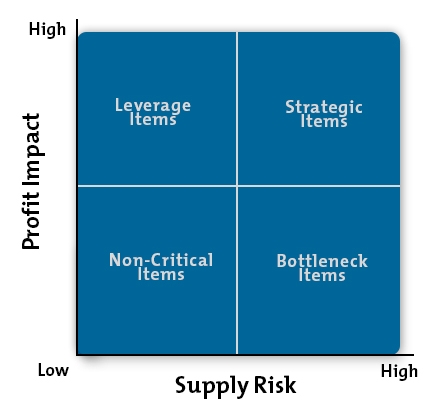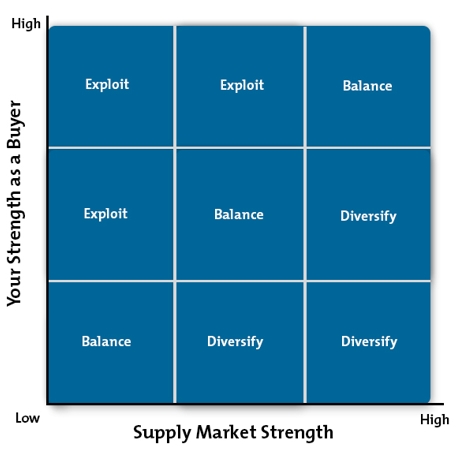The Kraljic Portfolio Purchasing Model
Assessing Risk and Maximizing Profits

© iStockphoto
EyeScaTch
Classify your purchases.
You've just taken responsibility for purchasing at a major international logistics company, and you're reviewing all of the fuel purchases over the past two years.
The company spends a fortune on fuel, and it's hired you, in part, to look for ways to cut costs.
The problem is that, because of the diverse nature of your company's transportation methods (which cover air, ground, and ocean freight), each individual department purchases fuel separately. So, the air division purchases its own jet fuel, the trucking division purchases its own diesel, and the shipping freight division purchases its own oil.
How could you possibly reduce costs on such a necessary, but ultimately scattered, commodity? The Kraljic Portfolio Purchasing Model helps you do this.
Understanding the Kraljic Portfolio Purchasing Model
The Kraljic Portfolio Purchasing Model was created by Peter Kraljic and it first appeared in the Harvard Business Review in 1983. Despite its age, it's a popular and useful model used in companies worldwide.
Its purpose is to help purchasers maximize supply security and reduce costs, by making the most of their purchasing power. In doing so, procurement moves from being a transactional activity to a strategic activity – because, as Kraljic said, "purchasing must become supply management."
How to Use the Tool
The model involves four steps:
- Purchase classification.
- Market analysis.
- Strategic positioning.
- Action planning.
Let's explore each in more detail.
Step 1: Purchase Classification
Start by classifying all of the commodities, components, products, and services that you buy according to the supply risk and potential profit impact of each.
- Supply risk is high when the item is a scarce raw material, when its availability could be affected by government instability or natural disasters, when delivery logistics are difficult and could easily be disrupted, or when there are few suppliers.
- Profit impact is high when the item adds significant value to the organization's output. This could be because it makes up a high proportion of the output (for example, raw fruit for a fruit juice maker) or because it has a high impact on quality (for example, the cloth used by a high-end clothing manufacturer).
Then mark each item in the appropriate place on the product purchasing classification matrix shown in figure 1.
Figure 1 – Product Purchasing Classification Matrix

Reprinted by permission of Harvard Business Review. From "Purchasing Must Become Supply Management" by Peter Kraljic, September 1983. Copyright © 1983 by the Harvard Business School Publishing Corporation; all rights reserved.
Kraljic recommends the following purchasing approaches for each of the four quadrants:
-
Strategic items (high profit impact, high supply risk).
These items deserve the most attention from purchasing managers. Options include developing long-term supply relationships, analyzing and managing risks regularly, planning for contingencies, and considering making the item in-house rather than buying it, if appropriate.
Note that step 3, below, provides detailed options for the best purchasing approach for these items, after considering other factors.
-
Leverage items (high profit impact, low supply risk).
Purchasing approaches to consider here include using your full purchasing power, substituting products or suppliers, and placing high-volume orders.
-
Bottleneck items (low profit impact, high supply risk).
Useful approaches here include overordering when the item is available (lack of reliable availability is one of the most common reasons that supply is unreliable), and looking for ways to control vendors
-
Non-critical items (low profit impact, low supply risk).
Purchasing approaches for these items include using standardized products, monitoring and/or optimizing order volume, and optimizing inventory levels.
Step 2: Market Analysis
Here, you investigate how much power your suppliers have, and how much buying power you have as their customer. A good way of doing this is to use Porter's Five Forces analysis. (You'll use this information in the next step.)
Step 3: Strategic Positioning
Classify the products or materials you identified as "strategic" in Step 1 according to the supplier and buyer power analysis you did in Step 2. To do this, simply enter each item in the purchasing portfolio matrix, shown in figure 2, below.
Figure 2 – Purchasing Portfolio Matrix

Step 4: Action Plans
Finally, develop action plans for each of the products and materials you need on a regular basis according to where those items are placed in the matrix in figure 2.
The three purchasing strategies indicated are as follows:
-
Exploit – Make the most of your high buying power to secure good prices and long-term contracts from a number of suppliers, so that you can reduce the supply risk involved in these important items. You may also be able to make "spot purchases" of individual batches of the item, if a particular supplier offers you a good deal.
The only real caution is not to take any aggressive approach too far, just in case circumstances change.
-
Balance – Take a middle path between the exploitation approach and the diversification approach described below.
-
Diversify – Reduce the supply risks by seeking alternative suppliers or alternative products. For example, in our logistics example, could you use the railroad to ship some of your overland freight instead of relying solely on trucking companies?
You can also increase your buying power by consolidating to a single supplier. And, in other situations, you could bring the production of the item in-house.
Tip:
For more on the details of managing suppliers, see our article on Procurement Management.
Key Points
Purchasing should be part of corporate strategy. As such, it's important that purchasers know how to evaluate risk and maximize profits by having the right approach to procurement.
The Kraljic Portfolio Purchasing Model helps purchasers understand where their products are classified in terms of supply risk and profit contribution, and also know whether the balance of power lies with them or with their suppliers. Once you know this, you can select an appropriate purchasing strategy.
This site teaches you the skills you need for a happy and successful career; and this is just one of many tools and resources that you'll find here at Mind Tools. Subscribe to our free newsletter, or join the Mind Tools Club and really supercharge your career!






Here's the information about supplier power and buyer power we provide in the article about Porter's Five Forces:
"Supplier Power. This is determined by how easy it is for your suppliers to increase their prices. How many potential suppliers do you have? How unique is the product or service that they provide, and how expensive would it be to switch from one supplier to another?
The more you have to choose from, the easier it will be to switch to a cheaper alternative. But the fewer suppliers there are, and the more you need their help, the stronger their position and their ability to charge you more. That can impact your profit.
Buyer Power. Here, you ask yourself how easy it is for buyers to drive your prices down. How many buyers are there, and how big are their orders? How much would it cost them to switch from your products and services to those of a rival? Are your buyers strong enough to dictate terms to you?"
Using the context this information provides, look at each of your strategic products or materials and mark them on the matrix, deciding whether you have high, medium or low power as a buyer and whether your supplier for the product has high, medium or low power.
I hope this helps.
Yolandé
Mind Tools Team
" Classify the products or materials you identified as "strategic" in Step 1 according to the supplier and buyer power analysis you did in Step 2."
Thank you for sharing the link to the matrix tool.
Bill
Mind Tools Team